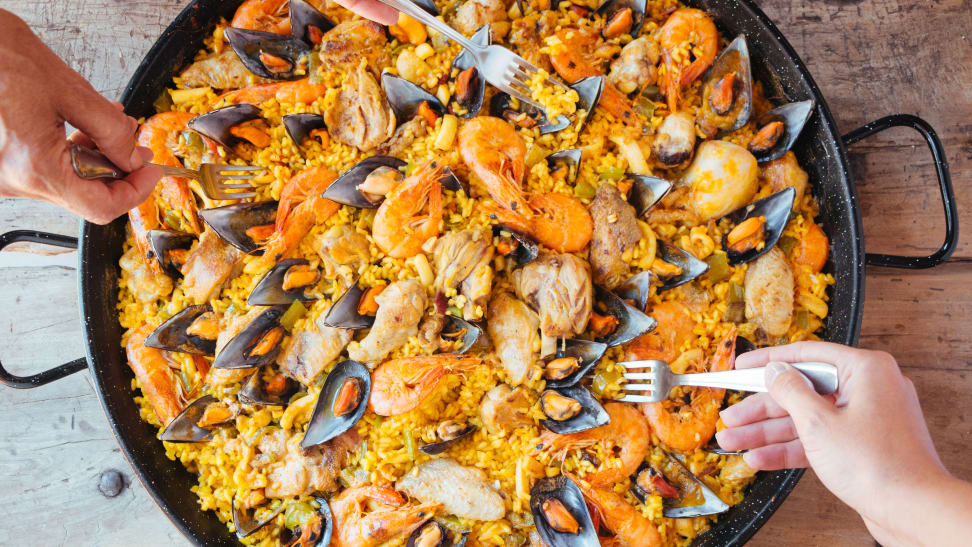Paella is the perfect summer crowd-pleaser—here's how to make it
Making paella at home is simple if you have the right tools.
 Credit:
Getty / ASIFE
Credit:
Getty / ASIFE
Recommendations are independently chosen by Reviewed's editors. Purchases made through the links below may earn us and our publishing partners a commission. Prices were accurate at the time this article was published but may change over time.
When we think about Spain, what comes to mind? For me, it’s chef Ferran Adrià, flamenco, and paella. While one-pot cooking has earned its fair share of both praise and controversy, paella is probably one of the few one-pot meals that won’t raise an eyebrow, even with the pickiest of food critics. And when you're cooking for a crowd, it strikes the perfect balance between dazzling and comforting.

Making a delicious paella is easy with the right tools.
Famous for its enormous size, paella is typically served at big family gatherings at which guests indulge themselves in plate after plate of saffron-infused rice, seafood, and chicken. As an aspiring home cook who loves to host, I often find cooking the same lamb roast, grilled meats, hot dogs and burgers to be a bit boring. I've learned that making paella at home is simple if you have the right tools—specifically, a carbon steel 15-inch paella pan that infuses the dish with authentic flavor.
How is a paella pan different from my normal pan?
Paella pans have dimples on the bottom, a design that is likely due to the fact that they used to be entirely hand-crafted. Some chefs say the dimples promote even cooking and help keep the pan rigid. The pans are compatible with gas and electric stovetops, but not always induction—the dimples on the bottom prevent complete contact with induction cooktops, which can lead to uneven cooking.
Traditional paella pans are also uniquely made with durable carbon steel, which requires more care than your typical stainless steel skillet, but ultimately enhances the flavor of the dish.
How do I prepare and season my paella pan?

Adding white vinegar can help remove the pan's anti-rust coating.
When you buy a brand-new pan to cook for the first time, you’ll first need to remove the thin coat of varnish on the pan's interior. To remove the protective layer, simply pour one quarter inch of water and a splash of white vinegar into the pan. Let the water sit for about 10 minutes until bubbles begin to form, and then dump the water.
Wash the pan with soapy water, then dry carefully with paper towel. Then, using a paper towel, lightly rub vegetable oil onto the surface of the pan to season it and prevent future rusting.
Now that your pan’s all set, let's get cooking.
Recipe: Classic Seafood Paella (serves six)
The origin of Valencian paella can be traced back to the Middle Ages, when the Moors reigned on the Iberian Peninsula. The Arabs brought rice cultivation to modern-day Spain, and the delicious medium grain rice, bomba, has made its way into many traditional Spanish and Portugese dishes since then. Traditionally, people cook paella on an open fire. We developed this recipe for stovetop burners for indoor cooking.

Make sure to spread the rice evenly in the paella pan.
Bring the broth back on heat. Add the rice to the paella pan and let it cook for two minutes. Turn heat to medium high and gently pour in four and a half cups of the seafood broth and stir the pan to evenly distribute the rice. Arrange the clams in the pan, submerging them as much as possible below the level of the liquid. From this point on, do not stir the rice.
Simmer vigorously and try to use multiple burners if possible to evenly cook the rice. When the rice comes up to the same level as the liquid, reduce the heat to medium low. Now you can start arranging the mussels in the pan (because mussels cook faster than clams).

Make sure to add the clams before the mussels, as the former cooks more slowly.
Continue to simmer and rotate the pan until all the liquid has been absorbed. This normally takes about 10 minutes. Taste a grain just below the top layer of the rice and see if there’s a tiny white dot in the middle. The white dot indicates the rice is cooked. If the rice is not cooked, then add more time. Bring back the seafood mix and arrange it in the pan.
5. Create the socarrat
Turn the heat back to medium high. Rotate the pan and cook for two minutes until the bottom rice starts to caramelize. Be careful not to let the bottom burn.
6. Let the paella rest, then serve
Remove the pan from heat and cover loosely with tinfoil or kitchen towel for five minutes to let the flavors meld. A color-balanced pan full of paella makes a great centerpiece. You should serve yours directly from the pan with lemon wedges for some fresh flavor.

You should serve paella directly from the pan.
How to clean a paella pan after use
Wash and clean off any solid residue, then soak the pan in water for a few hours or overnight. For carbon steel pans, you can also clean with steel wool. After drying the pan, lightly coat it with canola oil or any type of vegetable oil to prevent rusting. Wash the oil layer off before you use it next time.





